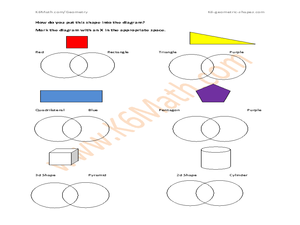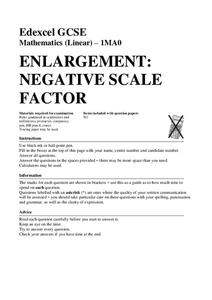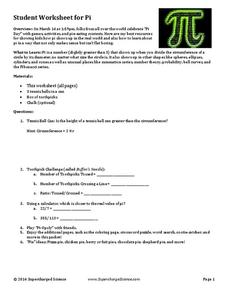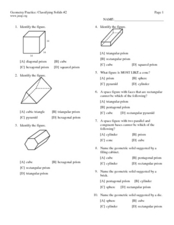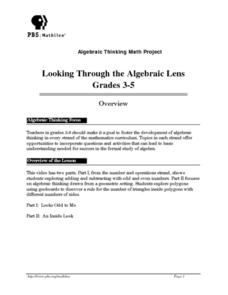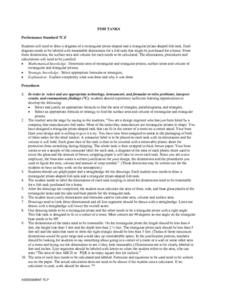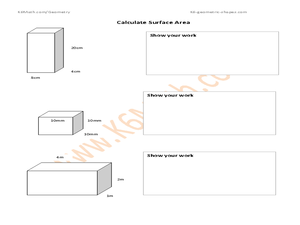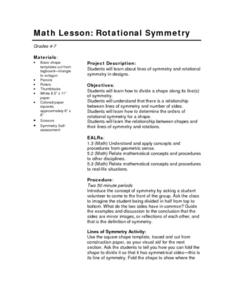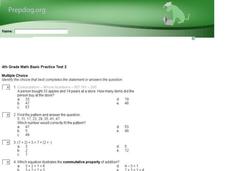Curated OER
Shapes: Putting Shapes in Diagrams
In this shape worksheet, students determine which shapes can be put into which pictures of diagrams, marking the correct diagrams, 6 shapes total. A reference web site is given for additional activities.
Mathed Up!
Negative Scale Factor
Class members investigate the effect of a negative scale factor dilation on coordinate shapes as they watch a short video that shows an example of a geometric figure undergoing a dilation with a negative scale factor. Learners then try a...
Mathed Up!
Angles
What does a geometric farmer drive? A protractor, of course! A set of assessment worksheets prompts learners to use a protractor as they measure angles, name angles, and identify lines. Use the video as a way to...
Curated OER
Worksheet for Pi
Who needs a pie-eating contest when you have a pi-ology game! Celebrate March 14th with a fun board game about pi and other geometric concepts. As learners answer questions about geometry, they move around the board to collect...
Curated OER
Geometry Practice: Classifying Solids #2
In this solids worksheet, students identify the characteristics of solids. They name solids and determine the number of faces. This three-page worksheet contains seventeen problems. Answers are listed on the last page.
Curated OER
Hop To It!
Young scholars determine patterns. In this mathematics lesson, students act out a skit, play a sequence game, and complete patterns. Young scholars use problems solving skills.
Curated OER
Looking Through the Algebraic Lens
Students work with rectangles to find generalizations for adding and subtracting odd and even numbers in part one of the lesson. In part two, students use geoboards to construct polygons, look for patterns, and find a general rule.
Curated OER
Fish Tanks: Volume and Surface Area
Given a very realistic challenge, your young geometers design residential fish tanks in rectangular and triangular prism shapes. They compute the volume of water each will hold. They also determine the size of plastic covers for each...
Curated OER
Triangles, Triangles, Triangles
Students view several different types of triangles. They discuss attributes of a triangle with a partner. Students use a straw cut into pieces to create a triangle. They complete a Triangle Hunt worksheet (teacher created). Students...
Curated OER
Chinese Tangrams
Learners research the history of Chinese tangrams and complete tangram activities. In this tangram lesson, students complete Internet research to learn the history of Chinese tangrams. Learners construct a set of tangrams, compare the...
Curated OER
Plane and Solid Figures
Students define a plane and a solid shape. In this geometry lesson plan, students compare and contrast different geometric shapes as they relate to solids. They name the geometric solids based on their sides and edges.
Curated OER
Transformations-Shapes on the Move
Students examine transformations. In this math lesson, students view and describe flips, slides, and turns. Students practice making transformations with shapes.
Curated OER
Estimate then Measure the Angle #1
Practice angle estimation with a worksheet. First learners estimate three angles within 15 degrees, then they measure and name each angle. A reference website is given for additional activities.
Curated OER
Bold Bridges
Students explore bridge construction. In this bridge building activity, students view bridge websites and discuss how bridges are designed and built. Students design and construct their own bridge using the directions provided.
Curated OER
Plotting Coordinates
In this geometry skills instructional activity, students plot the listed coordinates on the provided graphs in order to identify the appropriate shapes.
Curated OER
Perimeter – Calculate in Units
In this geometry skills practice worksheet, students solve 4 problems that require them calculate the perimeter of 4 geometric figures.
Curated OER
Left-Middle-Right
In this shape recognition instructional activity, students respond to 3 questions that require them to record the name of the shapes located on the right, the left, and in the middle.
Curated OER
Similar and Congruent
In this shapes worksheet, students decide if the given shapes are similar, congruent, or neither. Students complete 4 problems.
Curated OER
Calculate Surface Area
In this geometry skills worksheet, students solve 3 problems that require them to calculate the surface area of geometric figures.
Curated OER
Math Lesson: Rotational Symmetry
Students analyze lines of symmetry and rotational symmetry in designs. They practice dividing a shape along its line(s) of symmetry and discuss the relationship between lines of symmetry and number of sides as well as rotations.
Curated OER
Find the Shape
Students identify points on the coordinate plane using ordered pairs and also plot the ordered pairs on the coordinate plane. They also use properties of shapes to identify polygons such as triangles and quadrilaterals
(square,...
Curated OER
Geometric Figures
In this geometric figures activity, 7th graders solve and complete 10 different problems that include measurement. First, they draw a reflection of a given shape over a line. Then, students draw a rotation of a different shape. They also...
Curated OER
Online Interactive Math: Upper Elementary: Mixed Skills
In this online math worksheet, students complete a 20 problem multiple choice online interactive worksheet with mixed skills including geometry, rounding, and three digit multiplication.
Curated OER
Quiz: Geometric Constructions-Congruence
In this congruent figures worksheet, students answer ten true or false questions. A sample question reads: "Two triangles are congruent when their shape and size will be the same."


